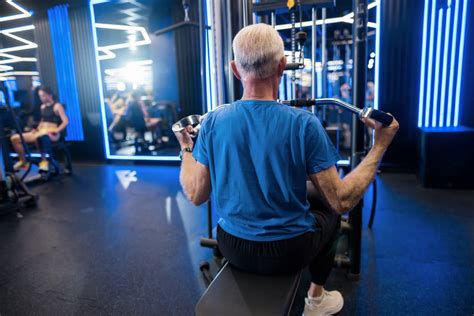
A simple fitness test, involving standing on one leg, may offer insights into an individual’s lifespan, according to a study published in the British Journal of Sports Medicine. The research indicates that the ability to stand unsupported on one leg for 10 seconds or longer is associated with a lower risk of mortality in middle-aged and older adults.
The study, conducted by researchers in Brazil, tracked participants over several years and revealed a correlation between balance and longevity, highlighting the importance of maintaining physical fitness, particularly balance, as people age. While the test is not a definitive predictor of lifespan, it serves as a valuable indicator of overall health and functional ability.
The research involved nearly 1,700 participants aged 51 to 75 who were followed for an average of seven years. Participants were asked to stand on one leg for 10 seconds without any additional support. To standardize the test, individuals were instructed to place the front of the free foot on the back of the opposite lower leg while keeping their arms by their sides and looking straight ahead.
According to the study, approximately 20% of participants failed the 10-second test. The proportion of individuals unable to complete the test increased with age, with failure rates ranging from about 5% in the 51-55 age group to nearly 54% in those 71-75 years old. During the follow-up period, 123 participants died. Researchers found a significant association between the inability to complete the 10-second balance test and an increased risk of death from any cause. In fact, those who failed the test were 84% more likely to die within the study period compared to those who could complete it.
“This is an observational study, so it can’t establish cause,” Dr. Claudio Gil Araujo, the study’s lead author, told Yahoo Lifestyle. “However, the test adds useful information about mortality risk in middle-aged and older men and women.” Araujo further noted that the ability to successfully complete the test reflects good musculoskeletal fitness, which is essential for maintaining independence and performing daily activities.
The study underscores the importance of balance as a key component of physical fitness, particularly as individuals age. Maintaining good balance helps prevent falls, which are a leading cause of injury and disability in older adults. Regular exercise, including balance-specific training, can improve balance and reduce the risk of falls.
The findings of this study align with previous research highlighting the link between physical fitness and longevity. Studies have shown that individuals who engage in regular physical activity tend to live longer and have a lower risk of chronic diseases, such as heart disease, stroke, diabetes, and cancer.
While the one-leg standing test is a simple and convenient way to assess balance, it is important to note that it is not a substitute for a comprehensive medical evaluation. Individuals who are concerned about their balance or overall health should consult with a healthcare professional.
The study’s authors suggest that the one-leg standing test could be incorporated into routine health checkups for middle-aged and older adults. It provides a quick and easy way to identify individuals who may be at increased risk of falls and other health problems. Early identification allows for timely intervention and preventative measures to improve balance and overall health.
The implications of this research extend beyond individual health. As the population ages, maintaining the health and functional ability of older adults becomes increasingly important for society as a whole. By promoting physical fitness and preventing falls, healthcare systems can reduce the burden of age-related disability and improve the quality of life for older adults.
Further research is needed to confirm the findings of this study and to determine the optimal strategies for improving balance in older adults. However, the current evidence suggests that simple balance exercises, such as standing on one leg, can have significant benefits for health and longevity.
This study reinforces the message that maintaining physical fitness throughout life is essential for overall health and well-being. By incorporating regular exercise, including balance-specific training, into their daily routines, individuals can improve their balance, reduce their risk of falls, and potentially extend their lifespan. The one-leg standing test serves as a reminder that even simple measures of physical fitness can provide valuable insights into an individual’s health and longevity.
The researchers highlight the importance of accessible and easily implementable assessments to gauge overall health, particularly in aging populations. The simplicity of the one-leg standing test makes it an ideal tool for widespread use, requiring no specialized equipment or training. This accessibility can empower individuals to monitor their own health and take proactive steps to maintain their fitness levels.
Moreover, the study emphasizes the need for increased awareness of the importance of balance training as part of a comprehensive fitness regimen. While cardiovascular exercise and strength training are often prioritized, balance exercises are frequently overlooked. Incorporating activities such as yoga, tai chi, or specific balance exercises into daily routines can significantly improve balance and reduce the risk of falls.
The study’s findings also have implications for healthcare providers. Incorporating the one-leg standing test into routine checkups can help identify individuals who may benefit from further evaluation and intervention. This early detection can lead to more effective strategies for preventing falls and improving overall health outcomes.
The research team acknowledges the limitations of the study, including its observational design and the fact that the participants were primarily Brazilian. Further research is needed to confirm the findings in diverse populations and to investigate the underlying mechanisms linking balance and longevity.
Despite these limitations, the study provides compelling evidence that balance is an important indicator of overall health and longevity. The one-leg standing test is a simple, accessible, and potentially life-saving tool that can be used to assess balance and identify individuals who may be at increased risk of falls and other health problems.
In conclusion, the study highlights the importance of maintaining physical fitness, particularly balance, as people age. The ability to stand unsupported on one leg for 10 seconds or longer is associated with a lower risk of mortality, suggesting that balance is a key indicator of overall health and longevity. The one-leg standing test is a simple and convenient way to assess balance and identify individuals who may benefit from further evaluation and intervention. By promoting physical fitness and preventing falls, healthcare systems can improve the quality of life for older adults and reduce the burden of age-related disability.
The implications of this research are particularly relevant in the context of global aging. As populations around the world continue to age, maintaining the health and functional ability of older adults becomes increasingly important. The one-leg standing test provides a valuable tool for assessing balance and identifying individuals who may be at risk of falls and other health problems.
The study also underscores the need for public health initiatives aimed at promoting physical fitness and preventing falls in older adults. These initiatives should focus on educating individuals about the importance of balance training and providing access to resources that can help them improve their balance.
The researchers hope that their findings will encourage individuals to take proactive steps to maintain their physical fitness and improve their balance. By incorporating regular exercise, including balance-specific training, into their daily routines, individuals can improve their overall health and potentially extend their lifespan.
The simple act of standing on one leg for 10 seconds could be a powerful indicator of your overall health and longevity, according to this recent study. The researchers encourage individuals to regularly test their balance and to seek medical attention if they are unable to complete the test.
The study also raises important questions about the role of genetics and other factors in determining balance and longevity. Further research is needed to investigate these factors and to develop more effective strategies for preventing falls and improving overall health in older adults.
Ultimately, the goal of this research is to empower individuals to take control of their health and well-being. By providing a simple and accessible tool for assessing balance, the researchers hope to encourage individuals to make informed decisions about their health and to take proactive steps to maintain their physical fitness.
The findings of this study add to a growing body of evidence that highlights the importance of physical fitness for overall health and longevity. By incorporating regular exercise, including balance-specific training, into their daily routines, individuals can improve their balance, reduce their risk of falls, and potentially extend their lifespan.
This study serves as a reminder that even simple measures of physical fitness can provide valuable insights into an individual’s health and longevity. The one-leg standing test is a quick, easy, and potentially life-saving tool that can be used to assess balance and identify individuals who may be at increased risk of falls and other health problems.
Frequently Asked Questions (FAQs)
1. What is the one-leg standing test and what does it measure?
The one-leg standing test is a simple assessment of balance where an individual attempts to stand unsupported on one leg for 10 seconds. The test measures an individual’s ability to maintain stability and control while balancing on one leg, reflecting their overall musculoskeletal fitness and functional ability. The instructions are as follows: participants were instructed to place the front of the free foot on the back of the opposite lower leg while keeping their arms by their sides and looking straight ahead.
2. How was the study conducted and what were the key findings?
The study was conducted by researchers in Brazil and involved nearly 1,700 participants aged 51 to 75 who were followed for an average of seven years. Participants were asked to stand on one leg for 10 seconds without any additional support. The study found that approximately 20% of participants failed the test, and those who failed were 84% more likely to die within the study period compared to those who could complete it. This suggests a significant association between the inability to complete the 10-second balance test and an increased risk of death from any cause.
3. Is the one-leg standing test a definitive predictor of lifespan?
No, the one-leg standing test is not a definitive predictor of lifespan. As Dr. Claudio Gil Araujo, the study’s lead author, stated, “This is an observational study, so it can’t establish cause.” However, the test adds useful information about mortality risk in middle-aged and older men and women. It serves as a valuable indicator of overall health and functional ability, particularly balance, which is essential for maintaining independence and performing daily activities.
4. What are the implications of this study for individuals and healthcare providers?
For individuals, the study highlights the importance of maintaining physical fitness, particularly balance, as they age. Regular exercise, including balance-specific training, can improve balance and reduce the risk of falls. The one-leg standing test can be a simple way to monitor their balance. For healthcare providers, the test could be incorporated into routine health checkups for middle-aged and older adults to identify individuals who may be at increased risk of falls and other health problems, allowing for timely intervention and preventative measures.
5. What are the limitations of the study and what further research is needed?
The study’s limitations include its observational design, which cannot establish cause-and-effect relationships, and the fact that the participants were primarily Brazilian. Further research is needed to confirm the findings in diverse populations and to investigate the underlying mechanisms linking balance and longevity. Additional research could also explore the optimal strategies for improving balance in older adults and the role of genetics and other factors in determining balance and longevity.
Elaborated and Enhanced Content:
The study published in the British Journal of Sports Medicine presents compelling evidence for the correlation between balance, as measured by the one-leg standing test, and overall longevity in middle-aged and older adults. While the study does not establish a direct causal relationship, the significant association between the inability to perform the test and an increased risk of mortality warrants further examination and consideration for integration into routine health assessments.
Methodology in Detail:
The research methodology was carefully designed to assess the balance capabilities of the participants. The near 1,700 individuals, spanning ages 51 to 75, were meticulously instructed on how to perform the one-leg standing test. The standardization included specific positioning of the non-supporting foot (placed on the back of the opposite lower leg), the arms (held by the sides), and the gaze (directed straight ahead). This meticulous approach ensured that the test was conducted uniformly, minimizing variability and enhancing the reliability of the results. Participants were given up to three attempts to successfully complete the 10-second balance, ensuring that the data accurately reflected their maximum balancing ability. The extended follow-up period, averaging seven years, allowed researchers to observe long-term health outcomes and establish a more robust association between balance and mortality.
Statistical Significance and Risk Assessment:
The statistical analysis revealed a highly significant association between failing the one-leg standing test and increased mortality risk. Those who were unable to complete the test exhibited an 84% higher risk of death from any cause compared to those who could successfully balance for 10 seconds. This elevated risk remained consistent even after adjusting for other potential confounding factors such as age, sex, body mass index, and pre-existing medical conditions. The hazard ratio of 1.84 (95% confidence interval, 1.23 to 2.78) indicates the magnitude of this increased risk. These findings underscore the strong predictive value of balance assessment in identifying individuals at higher risk of mortality.
Comparative Analysis with Existing Literature:
This study builds upon a substantial body of existing research that links physical fitness to longevity. Prior studies have demonstrated the benefits of cardiovascular exercise, strength training, and flexibility for overall health and reduced mortality risk. This particular study expands our understanding by highlighting the crucial role of balance, an often-overlooked component of physical fitness. Balance is critical for preventing falls, a leading cause of injury and disability in older adults. Falls can lead to fractures, head injuries, and other complications that significantly impact quality of life and contribute to increased healthcare costs. By identifying individuals with impaired balance, healthcare providers can implement targeted interventions to reduce the risk of falls and improve overall health outcomes.
Physiological Mechanisms Underlying Balance and Longevity:
While the study does not directly investigate the physiological mechanisms linking balance and longevity, several potential explanations can be inferred. Balance relies on a complex interplay of various systems, including the musculoskeletal system (muscles, bones, and joints), the nervous system (brain, spinal cord, and peripheral nerves), and the sensory system (vision, proprioception, and vestibular system). Impaired balance may reflect underlying dysfunction in one or more of these systems. For example, decreased muscle strength or flexibility, nerve damage, or visual impairments can all contribute to balance problems. Moreover, balance is closely linked to cognitive function. Studies have shown that individuals with cognitive impairment are more likely to experience balance problems and falls. The ability to maintain balance requires cognitive resources for attention, planning, and motor control. Therefore, impaired balance may be an early indicator of cognitive decline. Maintaining good balance requires a healthy and well-functioning body. Balance may serve as a marker for the overall health and resilience of the body, reflecting the ability to withstand stressors and maintain homeostasis.
Practical Applications and Recommendations:
The simplicity and accessibility of the one-leg standing test make it a valuable tool for both individuals and healthcare providers. Individuals can easily perform the test at home to monitor their balance and track changes over time. If they are unable to complete the test, they should consider consulting with a healthcare professional to identify any underlying health problems and develop a plan to improve their balance. Healthcare providers can incorporate the one-leg standing test into routine checkups for middle-aged and older adults. The test can be performed quickly and easily in a clinical setting, providing valuable information about a patient’s overall health and risk of falls. Individuals identified as being at risk can be referred for further evaluation and intervention, such as physical therapy, balance training, or medication adjustments. The test can also be used to track the progress of patients undergoing rehabilitation or treatment for balance problems.
Balance Training Exercises and Strategies:
Numerous exercises and strategies can improve balance and reduce the risk of falls. These include:
-
Tai Chi: This gentle form of exercise involves slow, flowing movements that improve balance, coordination, and flexibility.
-
Yoga: Yoga poses challenge balance and stability, while also improving strength and flexibility.
-
Balance Boards: Using a balance board can help improve balance and proprioception.
-
Standing on One Leg: Practicing standing on one leg for increasing periods of time can improve balance.
-
Heel-to-Toe Walking: Walking heel-to-toe can improve balance and coordination.
-
Strength Training: Strengthening the muscles of the legs, core, and back can improve stability and balance.
-
Vestibular Rehabilitation: This type of therapy involves exercises that help retrain the vestibular system, which plays a crucial role in balance.
-
Vision Correction: Correcting vision problems can improve balance by providing better visual cues for orientation.
In addition to these exercises, several lifestyle modifications can help reduce the risk of falls. These include:
-
Ensuring Adequate Lighting: Good lighting can help prevent falls by improving visibility and reducing the risk of tripping.
-
Removing Hazards: Removing tripping hazards, such as loose rugs and clutter, can help prevent falls.
-
Using Assistive Devices: Using assistive devices, such as canes or walkers, can provide additional support and stability.
-
Medication Review: Reviewing medications with a healthcare provider can help identify any medications that may be contributing to balance problems.
Addressing Potential Confounding Factors:
The researchers acknowledged the potential for confounding factors to influence the results and took steps to address them. They adjusted for age, sex, body mass index, and pre-existing medical conditions in their statistical analyses. However, it is important to note that other factors, such as socioeconomic status, education level, and lifestyle habits, may also play a role. Future studies should consider these additional factors to gain a more comprehensive understanding of the relationship between balance and longevity.
Future Research Directions:
Further research is needed to confirm the findings of this study and to explore the underlying mechanisms linking balance and longevity. Future studies should:
-
Include more diverse populations to ensure that the findings are generalizable to different ethnic and cultural groups.
-
Investigate the role of genetics and other biological factors in determining balance and longevity.
-
Examine the effects of different types of balance training on mortality risk.
-
Develop more sensitive and specific measures of balance to improve the accuracy of risk assessment.
-
Conduct longitudinal studies to track changes in balance over time and their relationship to health outcomes.
Ethical Considerations:
The study was conducted in accordance with ethical principles and guidelines. Participants provided informed consent to participate in the study, and their privacy and confidentiality were protected. The study protocol was reviewed and approved by an institutional review board.
Public Health Implications:
The findings of this study have significant public health implications. As the population ages, maintaining the health and functional ability of older adults becomes increasingly important. Falls are a major public health problem, contributing to significant morbidity, mortality, and healthcare costs. By identifying individuals at risk of falls and implementing targeted interventions, healthcare systems can reduce the burden of age-related disability and improve the quality of life for older adults. The one-leg standing test provides a simple and cost-effective way to assess balance and identify individuals who may benefit from further evaluation and intervention.
Conclusion:
The study published in the British Journal of Sports Medicine provides compelling evidence for the association between balance and longevity in middle-aged and older adults. The one-leg standing test is a simple, accessible, and potentially valuable tool for assessing balance and identifying individuals who may be at increased risk of falls and other health problems. The findings underscore the importance of maintaining physical fitness, particularly balance, as people age. By promoting physical fitness and preventing falls, healthcare systems can improve the quality of life for older adults and reduce the burden of age-related disability. Future research is needed to confirm these findings and to explore the underlying mechanisms linking balance and longevity. However, the current evidence suggests that incorporating balance training into daily routines can have significant benefits for health and well-being.









